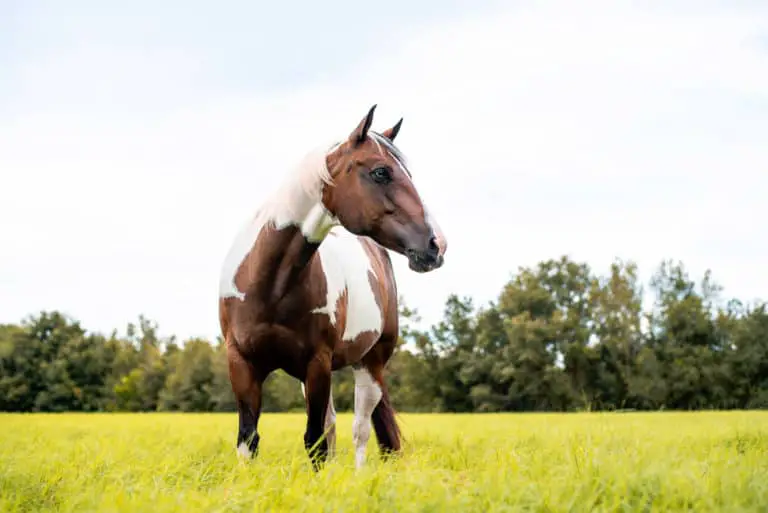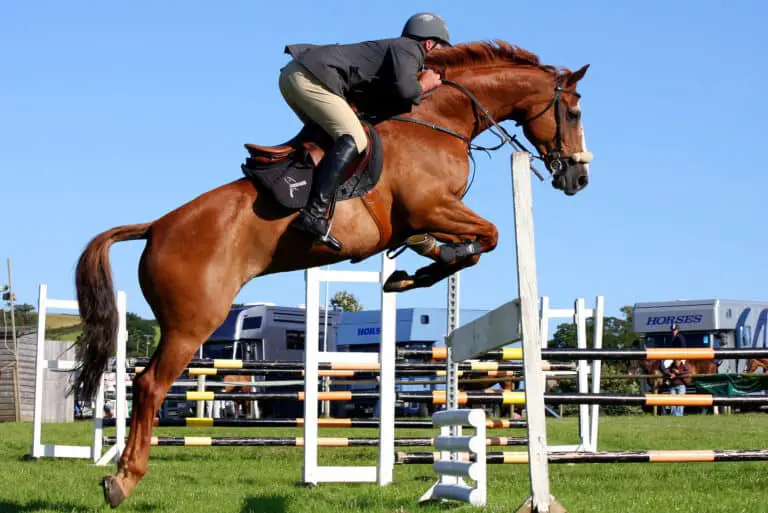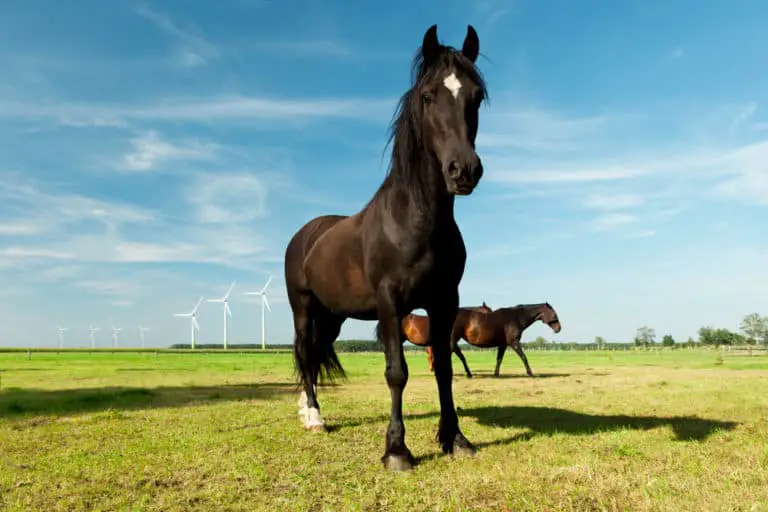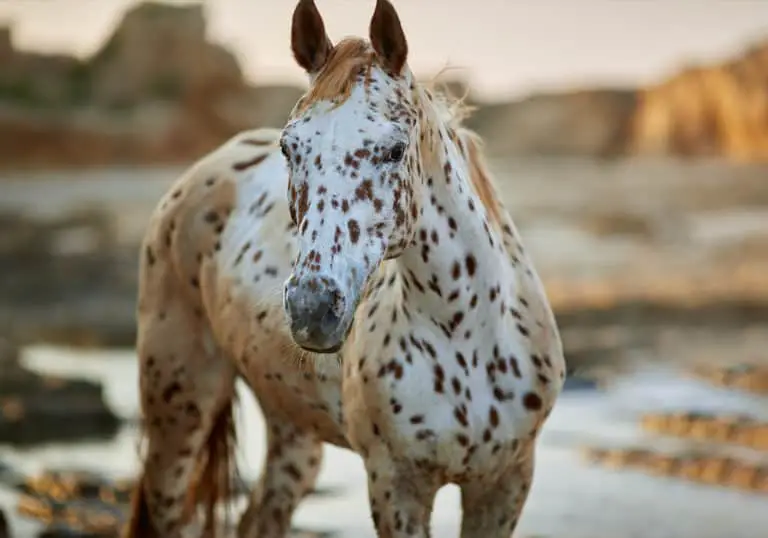Belgian Horse Breed: Care, Cost & History (2025)
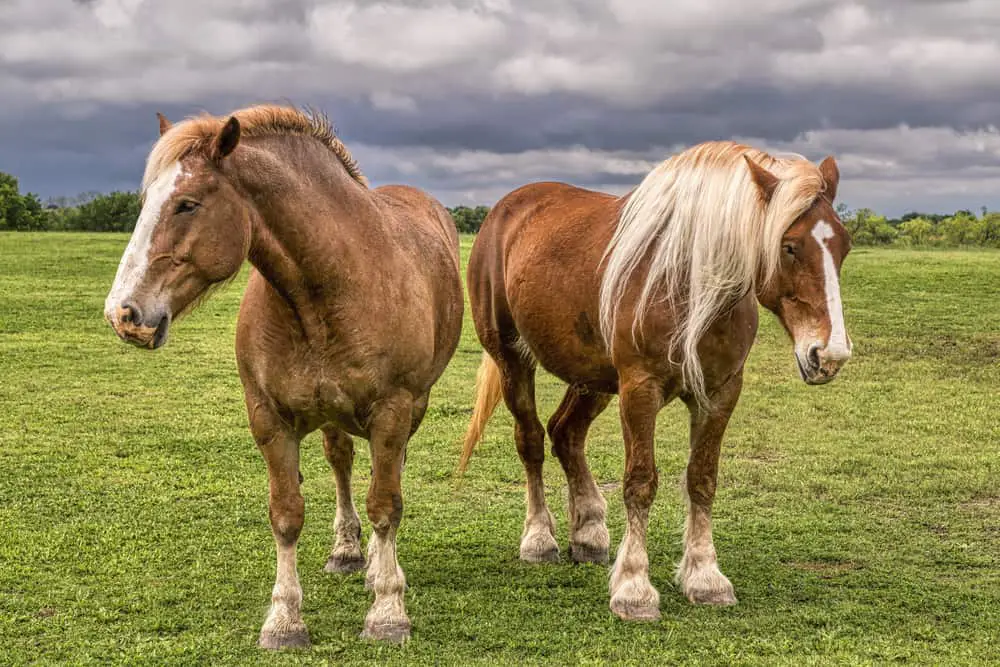
The Belgian horse is a large breed known for being one of the strongest draft horses. They originated in Belgium, a European country, and have the purest connection to the Great Horses bred to carry medieval knights into battle. Today, they are the most popular breed of draft horses in many countries, including the United States.
Breed: Belgian horse
Adult Weight: 1,800-2,400 pounds
Adult Height: 16-18 hands (64-72 inches)
Origin: Belgium
Use: Draft, Pulling
Colors: Bay, chestnut, sorrel, or roan with blonde mane and tail
Features: Large size, well-muscled, short legs with feathers, powerful hindquarters
Lifespan: 20 years
Character: Gentle and docile, very strong
Gait: Ground-covering stride, sure-footed
Best for: All levels of riders
- Characteristics
- Belgian Horse Care
- Belgian Horse History
- Modern Belgians
- Cost and Ownership
- Buying a Belgian
- Similar Breeds
Belgian Horse Characteristics
Belgian horse characteristics are distinct among drafts. The Belgian horse head is small compared to its body. They have a kind eye and straight nose. Belgians have a thick neck – especially stallions, broad chest, and their back is short and wide. The hindquarters are powerful. Legs are short with feathers around the large, shapely hooves.
Size
Belgian horse height is between 16 to 18 hands high, or 64 to 72 inches, making them one of the tallest draft horse breeds. (1) The longtime record holder for the world’s tallest horse is a Belgian named Big Jake. He is 20 hands and 2.75 cm – without shoes – and lived on a farm in Wisconsin in the United States.
Males are usually taller than females, and the non-adult horses grow into their full height over the first five years of their life. Belgian size in the United States is usually taller than their European counterparts. The height further enhances their power.
Weight
Belgian horse weight is between 1,800 and 2,400 pounds. Height and bloodlines influence weight, with European horses weighing more. Stallions weigh more than mares, and this is evident in their breed characteristics, like the thicker neck. The bones are clean and flat in the Belgian horse and easily carry the horse.
The average Belgian foal weighs about 125 pounds when it’s born and won’t be fully mature until it reaches five years of age. For perspective, Big Jake was 240 pounds when he was born.
The heaviest horse on record, Brooklyn Supreme, was a Belgian that weighed 3,200 pounds. “Brookie” lived from 1928 to 1948 and was 19.2 hands and had 30-inch horse shoes.
Colors
The beautiful Belgian horse is commonly a blonde, chestnut, or sorrel with a light blonde mane and tail. This color is predominant in the United States and many associates it with the breed, the chestnut is the darkest of these three.
But, there are other Belgian horse colors: bays, browns, and there are also red and blue roans. Grays and blacks are rare Belgian horse colors.
Write hairs are usually interspersed with all the coat colors. Belgians can also have white markings on their face and lower legs. Blazes on the face and socks or stockings that stop below the knee and hock are most common.
Temperament
Belgian horse temperament is known as gentle and kind, they are also cooperative and willing to work, which is one of the reasons they are such a popular workhorse breed. Belgian horse behavior is calm, and they rarely spook. But, they also have a sense of humor and distinct personality.
These traits make them a good breed with humans, and many small children are often seen showing or handling the horses because they have such great temperaments. It’s a breed the whole family can use and enjoy.
The Belgian horse uses the general rules from the United States Equestrian Federation. These rules state that children are not allowed to exhibit stallions. (2)
Belgian Horse Care
These gentle giants are easy to care for, even by the youngest members of the family. The Belgian horse lifespan is 20 years, a little less than some breeds due to their large size. The breed is hardy and withstands cold temperatures well, spending much of their time outside when given a choice.
Diet and Nutrition
Here’s the thing, Belgian horses require a lot of feed! They are bigger than other horses, therefore they eat more than a regular-sized horse. But, they have a slower metabolism than regular-sized horses, so they eat more but need less energy. (3)
Therefore, grass and hay are the largest part of their diet. A hay test can analyze the nutritional content of the hay. Grain and supplements are added to the Belgian diet after the hay is analyzed. (3)
Big Jake ate a whole bale of hay by himself every day. (4) But, Belgian horses also gain weight easily if they aren’t working hard, so it’s important to monitor their feed intake and activity level. (4)
Health Problems
The Belgian horse breed has some health problems. Those that are working hard can get azoturia, also called tying up. Owners can prevent this by administering electrolytes and making sure horses drink plenty of water. (4)
Belgian horses have some genetic problems too. The first is chronic progressive lymphedema, which causes swelling in the legs, and also distorts the skin. (4) The second issue is junctional epidermolysis bullosa (JEB). If two horses that both have the JEB gene are bred, the foal loses large chunks of skin and has to be euthanized. (4)
A lot of horses have the JEB gene and the United States breed registry requires testing and research to eliminate JEB is ongoing. (5)
Grooming
The Belgian draft horse needs to be groomed every day. It’s easy to groom the breed because they are so gentle and calm. Most owners and caretakers do end up using a stool or ladder of some sort though because they are such tall horses. (5)
Belgian grooming is necessary because they’re prone to mud disease or scratches. This is dermatitis or skin issue that affects their pasterns and is painful. Belgians are more susceptible because bacteria can hide behind their feathers. (4)
Daily cleaning of the pasterns and legs can prevent any issues. Hooves should also be cleaned daily to prevent any hoof rot or abscesses. (4)
Belgian Horse History
Belgian horse history begins in the Brabant region of Belgium. Their earliest use was a Belgian war horse, and then as workhorses. Their calm demeanor made them popular as they were exported throughout Europe and to North America. Even though a Belgian workhorse isn’t needed today, these gentle giants have remained popular horses.
Origin
The Belgian breed is still referred to as Brabant horses by some, especially in Europe. Although careful breeding didn’t start until the 1600s, its thought that Belgian horse origin goes back to the Great Horse that medieval knights used in battle during the Middle Ages.
The horses were also used for farm work, pulling wagons, transportation of goods and people, and any other job that required power. Of course, they were also used to pull heavy artillery during the world wars.
Mechanization after World War II changed their role. Today, they are still used for farm work and logging by some, and also in tourism, and as pleasure riding and driving horses.
Historic Development
For much of its early history, the Belgian draught horse remained unchanged. Exports throughout Europe and to North America likely saw some adaptations but nothing striking. The historic development of the breed did change after World War II though.
In Europe, Belgian breeding remained the same, with heavy horses. Breeders in the United States started trending towards a taller horse that wasn’t as heavy as its European counterparts.
Today, these are two distinct types of Belgian drafts, and a separate breed organization in the United States preserves the American Brabant. These horses have 25% to 99% Europan Belgian bloodlines and exhibit the same type as their European counterparts.
Notable Belgian Horses
Every Belgian draft horse is famous to those that own them and love the breed. The Belgian horse pedigree has produced amazing horses that worked alongside humans for generations.
Among the millions of horses throughout the years, a few famous Belgian horses stand out more than their peers. Their stories represent the kindness and power of the breed.
Big Jake
Big Jake was a Belgian gelding who held the Guinness world record for the tallest horse until he passed away in June 2021. Jerry Gilbert and his family at Smokey Hollow Farm in Wisconsin owned him; Jake was treated as part of the family. He was a celebrity and people often visited him on the farm.
Rock
Rock was a Belgian draft horse that belonged to Dick Wallingford, a logger from West Forks, Maine. Rock was used in pulling competitions and was in a 1974 issue of Sports Illustrated when he was 12. He got a new partner and set a world record in 1981; the team pulled 22,000 pounds for 66 inches.
Dick
Dick is the sidekick that changed the game. For years, Rock basically pulled alone; his partner didn’t help. Then, Wallingford found Dick the horse in southern Indiana. Ironically, Rock and Dick had pastured together as colts. The dream team began – Wallingford didn’t touch or encourage the horses. Once hitched, they pulled, and did it together, with some amazing results.
Myths and Legends
Among Belgian horse legends, there are many that date back hundreds of years, to the incredible power these horses supplied during the Middle Ages and as workhorses and sources of transportation. Their legendary status extends to modern times too, part of the breed’s allure is it continues to amaze people and create lasting memories.
Coat of Many Colors
The Belgian didn’t start out with distinct reddish-brown coat color and blonde mane and tail that is so easily recognized today. The Brabants come in many colors in Europe and still have other coat colors. The chestnuts with their flaxen manes and tail, white blazes on the face, and white socks are most popular in the United States.
The Team That Loved to Pull
Rock and Dick became a legendary team, not just because they pulled the heaviest loads the furthest, but because of the way, they pulled them. Wallingford, their owner, didn’t encourage the horses at all. The reins were slack, and he didn’t use a hitch. Observers compared Rock and Dick pulling to Wallingford driving a Rolls Royce car.
Disney Attraction
Disneyland in California includes horse-drawn trolleys traveling up and down Main Street. Belgian draft horses are a huge part of the crew of horses delighting and transporting park visitors. One of the longest-serving horses was a Belgian, and when they retire, horses are often adopted by their park caretakers.
Modern Belgian Horses
The Belgian remains the most popular draft breed in the United States, with more Belgians than all of the other draft breeds combined. There are two types of Belgian horses, the modern Belgian and the American Brabant, that resembles and maintains their European bloodlines. Both are used for working, as well as enjoyed by their owners.
Breeding
Today’s Belgian horse is found throughout the world, often with different names. The Belgian and North America and Brabant in Europe are the two most common. Belgian breeding continues among breed enthusiasts and the bloodlines used to perpetuate these two types of horses, as well as their docile and willing temperaments.
In the 1800s, the government of Belgium was involved in Belgian horses breeding, and this helped establish strong bloodlines and breed dominance throughout Europe and eventually in North America.
Although government-led breeding no longer plays a role, smaller breeders appreciate the Belgian’s attributes and perpetuate those through their breeding programs. They are considered the Cadillac among draft horses.
Population
The Belgian horse population in the United States includes around 4,038 new horses registered every year, making the total population around 80,000 horses. (6) There are only a few hundred registered Brabant horses in the United States, and they are considered endangered but the Belgian is not. (7)
In Belgium, the horse population remains around 300,000, and they have about the same number of Belgians or Brabant horses as the United States population.
Other members of the breed are located throughout Europe and the breed is not considered endangered, although population numbers in some countries are low. (8) Canada also has a Belgian horse population, although only around 300 horses are registered each year. (9)
Uses
The Belgian is a versatile horse breed, in part because of their kind and willing temperaments. Belgian horse uses include plowing, logging, and pulling carriages at theme parks and in city streets.
They have become popular riding horses for a variety of disciplines and are used in vaulting competitions. People also compete in draft horse hitch driving classes and pulling contests.
The Belgian horse gait is another reason they have so many uses. The horses have an animated trot, flexing their knees and hocks in a smart cadence that is beautiful to watch. The horses are smooth to ride, despite their large size.
Belgian Horse Prices
The Belgian horse price begins with the purchase price, and then includes their care – feed, shelter, and health. The cost for a Belgian is higher than other horses because they are so large, they need more space and feed. The initial purchase price can be higher given their uses as workhorses and in tourism jobs like pulling carriages.
Purchase Price
The average price of a Belgian horse is between $5,000 and $15,000, depending on the horse. (9) For example, a mature, fully-trained stallion with exceptional bloodlines will cost closer to $15,000. A foal will be at the lower end of the range, at only $5,000 as their potential talent and usefulness is still assumed, but not known. (9)
The most expensive draft horse ever purchased was a Belgian. McIlrath’s Captain Jim was a two-year-old Belgian stallion when he was purchased for $112,500 at a draft horse sale in 2003. Other members of the breed also have higher purchase prices when Belgian horse training is complete or based on their bloodlines. (9)
Ownership Costs
Horse ownership is expensive but well worth it. Many people only think about the initial purchase price of the horse; it’s important to consider board, feed, veterinary, and hoof care too. The Belgian horse cost of ownership is between $1,770 and $12,930 annually. Belgian price is on the higher end because of their size.
Board
Board is the infrastructure that supports the horse’s daily life, stall or shelter, and pasture. Draft horses need more space than other horses in their stall and outside to move around. Belgian horse board cost is between $1,200 and $7,200 each year, it costs more depending on the barn or shelter. (10)
Feed
Feed is the hay, grain, grass, and supplements a horse consumes for its diet and nutrition. It’s an essential cost that can’t be skimped on. Belgian horse feed cost is again on the high side of the range of $250 to $4,380 per year. (10) Remember, Big Jake ate a full bale of hay each day.
Veterinary Care
All horses need basic veterinary care, including vaccinations, deworming, and dental care to ensure they can eat their feed. This all needs to be done yearly to maintain the horse’s health. It’s about $250 to $350 each year for routine Belgian horse veterinary costs. An accident or injury will add to this expense. (10)
Hoof Care
The Belgian horse hoof care cost is $120 to $1,000 annually. (10) The hooves grow continuously, and must be trimmed, some Belgians need shoes to help support their weight and protect their hooves too; horses with shoes cost more. Some farriers only work with draft horses and can make recommendations for your horse.
Buying a Belgian Horse
Horse buying is exciting, it’s fun to begin looking for horses and imagining what could be. But, no one wants to suffer from buyer’s remorse. Start by doing some homework on the Belgian breed and horses available for sale. Clearly define your horse ownership goals and look for a horse that will help fulfill those goals.
Is the Belgian Horse Right for You?
Is the Belgian horse right for you? Well, if you want a kind horse, that’s willing to work and has a fun sense of humor, then yes, owning a Belgian is a good idea. These gentle giants love being with people and having a job, whether that’s driving, working in the woods, or going around a ring in a circle with a small child on their back.
Riding a Belgian horse is fun, you get a unique view of the world perched up on that tall horse. The wide back and calm demeanor build confidence and trust in riders. We don’t often think of draft horses as beginner-friendly, but the Belgian is the exception to that rule.
How to Buy a Belgian Horse?
Okay, you are ready to start shopping for a Belgian horse. First, locate a Belgian breeder, they know the most about horses in your area and those available for sale. A breeder can also explain which bloodlines are popular for riding versus driving, working versus pleasure.
Buying a Belgian horse takes some time, you want to look at several horses before purchasing one of them. Ride or drive the horse several times, and watch other people work them too. Groom them and spend time with them in the barn, and then have a veterinarian check the horse over. Avoid horses with bad attitudes or any soundness issues.
Similar Breeds to Belgian
There are Belgian breed alternatives if the perfect horse can’t be located. Clydesdales are similar in size and use, but more famous because of their Budweiser association. Friesians have a similar history in a smaller size. Finally, the American Cream Draft was developed in the United States with help from the Belgian breed.
Clydesdale
The Clydesdale Horse is a draft horse breed from Scotland that’s become famous for pulling the Budweiser wagon and appearing in Super Bowl commercials. These horses were also used extensively for farm work and transportation prior to mechanization. Clydesdales have calm temperaments like their Belgian counterparts. Uses today include working and pleasure riding and driving.
Friesian
The Friesian Horse breed developed in the Netherlands for pulling carriages and is considered a light draft horse. Friesians also carried knights to battle during the Middle Ages. They are elegant and athletic, with the same high knee and hock action we see in Belgians. Friesians also have feathers on their legs and surrounding their hooves, and striking black coats.
American Cream Draft
The American Cream Draft breed originated in Iowa, in the United States, and is known for its cream-colored coat. Horses are slightly smaller than Belgians at 1,600 to 1,800 pounds. The Belgian breed was used in the early development of the American Cream Draft. It’s a rare breed with a population level in the critically endangered range.
FAQ
What is a Belgian horse?
A Belgian horse is a draft breed with strength and power, they are popular for draft work, and also as riding horses.
What does a Belgian horse look like?
Belgian horses are tall, with thick, well-muscled bodies and short legs. They are usually a reddish-brown color and have powerful hindquarters.
How did the Belgian horse get its name?
The Belgian horse is named for the country of Belgium, where they originated from.
Can you ride a Belgian horse?
Yes, you can ride a Belgian horse, they are popular on the trail and in other disciplines.
Are Belgian horses good for beginners?
Belgian horses are great for beginners because they have a kind and docile temperament.
How tall is a Belgian horse?
A Belgian horse is between 16 and 18 hands tall, or 64 to 72 inches.
How much does a Belgian horse weigh?
Belgian horses weigh between 1,800 and 2,400 pounds.
How big is a Belgian horse?
A Belgian horse is big – they are tall and weigh a lot, but their kind personality makes them easy to work with.
How much does a Belgian horse cost?
Belgian horse prices vary; expect to pay between $5,000 and $15,000.
How much does Belgian horse ownership cost?
Belgian horse ownership costs between $1,770 and $12,930 annually.
How long do Belgian horses live?
The average Belgian horse lives for 20 years.
How fast can a Belgian horse run?
Belgian horses can run up to 25 miles per hour.
How much can a Belgian horse pull?
Belgian horses are one of the strongest draft breeds and can pull 2,700 to 3,600 pounds.
How much can a Belgian horse carry?
A Belgian horse can carry 360 to 480 pounds.
At what age is a Belgian horse full grown?
Most draft horses, including the Belgian, are not full-grown until they are five years old.
What are Belgian horses used for?
Belgian horses are used for draft work like logging, plowing, pulling carriages, and sleighs. They are also riding horses.
References
- Belgian Draft Horse Corporation. 2022. Fast facts. Link
- United States Equestrian Federation. 2022. Licensed Competitions. Link
- Department of Primary Industries. 2002. Feeding the working horse. Link
- Fédération Équestre Internationale. 2021. Breed Profile: The Belgian Draft Horse. Link
- Belgian Draft Horse Corporation. 2022. America’s Favorite Draft Horse. Link
- Belgian Draft Horse Corporation. 2022. History of the Belgian Draft Horse Corporation of America. Link
- European Braban. 2022. About the registry. Link
- Carolina Liljenstolpe, Swedish University of Agricultural Sciences. 2009. Horses in Europe. Link
- Canadian Belgian Horse Association. 2022. Link
- Arabian Horse Association. 2022. What is the Cost of Providing for Them? Link

